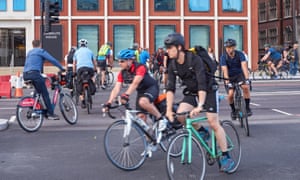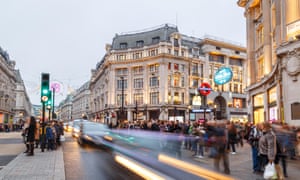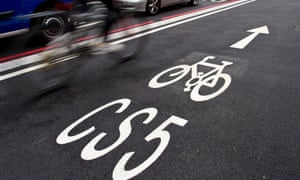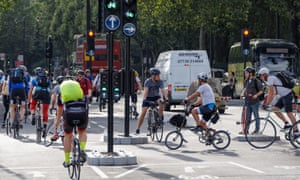There have been some tense moments in the battle to bring protected cycle lanes to London, but one of the most volatile took place one crisp Saturday morning last October, when protesters faced off beside a huge road junction in Swiss Cottage, north London.
One group, mostly well-heeled retirees from the neighbourhood, were against the proposed new CS11 cycle superhighway. They held up “Stop CS11” signs and told passersby that changes to the busy gyratory would bring congestion, pollution and rat-running drivers to their leafy streets.
Just metres away stood a group of Lycra-clad cyclists and some young families – including a pregnant couple who held up a sign saying they wanted their bump to cycle to school. They supported the new cycle route, which they argued would provide a safe, healthy alternative to car travel.
Around the corner, meanwhile, was a group from the Licensed Taxi Drivers Association, parked up with a large billboard demanding “Roads for all”.
paul gannon
(@paulgannonbike)London Taxi Drivers Assocation demonstration against congestion caused by cyclists pic.twitter.com/ZxOquLJ6NI
To begin their march, the “Stop CS11” protesters had to squeeze, single file, past the CS11 supporters – one side chanting “No to congestion, no to pollution, no to CS11”, the other “Bikes don’t pollute”. They might as well have been speaking different languages. What was a cordial conversation had turned toxic.
#CS11 supporters pointing out to anti-cycling protesters : bikes don’t pollute
A post shared by Laura Laker (@lakerlikes) on Oct 8, 2016 at 3:09am PDT
Into this charged atmosphere has been thrust Will Norman, London’s first walking and cycling commissioner. Norman is the man tasked with placating both sides – those angry about the introduction of cycle routes and pedestrian space to London’s crowded streets, and those impatient for change.
To make matters worse, his first day on the job, in February, came in the wake of three cycling deaths in the capital within four days, and the death of two pedestrians in the same week. In 2015 it is estimated that 66 pedestrians were killed on London’s roads, while in 2016 seven cyclists died in collisions with other vehicles in the capital.
And he has big shoes to fill. His predecessor, Andrew Gilligan, was known as a firebrand, but the controversial journalist nonetheless got the job done with then-mayor Boris Johnson. The city built 38 miles of cycle superhighways during his term, remodelled several major junctions and started the Quietway and mini-Holland projects that are still under construction.
Gilligan’s position on the CS11 debate was typically confrontational: he said “made-up claims” meant people had “fundamentally misunderstood” what was being built – which he said was essentially a protected cycle route from Swiss Cottage to the West End. He more or less pushed through the plans: work to transform the Swiss Cottage gyratory – returning it to two-way traffic, introducing a large public space and the protected cycle lane – will now start this autumn. (Discussions over another part of the route, through Regent’s Park, are ongoing.)
But Gilligan and Boris Johnson are gone. In the run-up to his election last May, Sadiq Khan promised to build 120 miles of cycle superhighways, 20 “liveable neighbourhoods” (rebranded mini-Hollands with a focus on walking, cycling and public transport) and more low-traffic, back-street Quietway cycling routes.

Yet almost a year since his election, no new routes have yet been proposed. Gilligan says he’s “almost certain” routes won’t be tripled in three years. And Khan and his deputy mayor for transport, Val Shawcross, came under fire after Khan said earlier this year that the previous administration took an “unnecessarily confrontational approach” in its cycling programme – a broadside that some observers think will mean a lot of time wasted trying to please everyone.
‘The right thing for London’
It’s safe to say Will Norman is on a charm offensive. We shake hands in a nondescript meeting room in the top floor of City Hall, which the warm spring sunshine has transformed into something of a greenhouse.
The man from Nike – he was their global partnerships director for almost two years, and trained as an anthropologist – has a formidable assignment. Air pollution in London is at its worst. Tens of thousands of children are now exposed to illegal levels of air pollution in the city’s schools. And there is growing impatience at delays to build what many see as the answer to these problems: cycle lanes.
Norman is certainly brimming with energy, which he will need over the 37 months until the next mayoral election. He points to a “very strong” electoral mandate to deliver cycling routes. Though he says he wants to encourage conversation and negotiation with concerned residents, businesses and boroughs, “ultimately they do need to be done”.
“It’s very clear the mayor’s agenda going forward is to prioritise walking and cycling and use of public transport,” he says. “It’s certainly the basis on which we made the transport strategy [due out for consultation in May]. Clearly there will be people who don’t necessarily agree with that but that’s the vision, we know it’s the right thing to do for London,” he says. “We will be doing this, I’m confident we will achieve that.”
He says he is finalising a programme of improvements to be delivered in 2017-18 to increase walking and cycling, while contributing to the draft transport strategy, and looking at how to encourage more Londoners to walk and cycle.
But many people worry that he is being too nice – and that combining cycling and walking will dilute the effectiveness of his role.

An insight into how Norman, Shawcross and Khan will balance pedestrian and cyclist needs will be the transformation of Oxford Street, which Norman calls a “pressing urgency for London”. When it opens in late 2018, Crossrail – the newly minted Elizabeth Line – will see 200,000 people pass through Tottenham Court Road Station daily, according to TfL. Plans will be released for consultation on 24 April, though Norman won’t say if this will be a shared cycling and walking route, or for pedestrians only.
Refocusing the mayor’s strategy to cycling and walking was a deliberate attempt to defuse the antagonism of the debate. Norman says the new job title represents a “seismic shift” in policy for London.
“For a long time, I think, walking has been undervalued in terms of policy and in terms of public conversation and engagement,” he says. “We have a fantastic opportunity in London to improve conditions for walking alongside a comprehensive cycle network.” He argues that much unites his two roles. “The biggest challenge for road safety is around motor vehicles, and how do we allow other forms of transport that are more sustainable.”
Indeed, TfL believes there are 2.4m trips daily in London that could be walked but aren’t. (Two-thirds of those are currently made by car.) With London’s population growing by 10,000 people every month, if everybody drove, nobody would get anywhere.
So far, however, little has been announced by City Hall. Although they wouldn’t reveal all plans Norman has been working on, they did confirm forthcoming consultations to transform two of London’s most dangerous junctions, Lambeth Bridge north and south, as well as consultations for Waterloo Imax roundabout, Kings Cross gyratory and Euston Road this summer. (Previous plans for Lambeth and Kings Cross have either done too little for cycling, or disrupted TfL’s traffic modelling.) A new “better junctions” programme will also be launched this year. And a major pillar of the cycle scheme will be the publication of the strategic cycle network plan, which will “identify the most important future cycle connections to prioritise”, and separate walking and cycling strategies.

It will be a challenge for Norman and Shawcross, however – not least because TfL will lose its entire operational budget by 2020.
Long game
To Norman, consulting with the small but vocal opposition is key – that and avoiding legal action. He sees the fight to encourage cycling in London as a long game.
“There are going to be occasions where we do need to push back, and that’s part of my job, but I don’t want to jump in pushing without actually listening to all the concerns, listening to concerns of residents, making sure that people are adequately consulted to, because this is long-term change for London,” he says. “We are talking about a significant change in infrastructure in terms of how people get around, and it’s not going to be achieved over one mayoral term, it won’t be over two mayoral terms. This is a long-term generational piece.
“We need to bring people along with that. There is a risk – we’ve seen it in some places – where you push too hard on things then you might get that one scheme done but … the next one people would already have put up their barricades and dug in.
“How do we make sure that this is being seen as winning the war, rather than just winning each individual battle?”
Lessons from New York
I put that to Janette Sadik-Khan, a woman who is very familiar with this fight. As New York’s former transportation commissioner, she oversaw unprecedented transformation of the city’s streets over her six-and-a–half-year tenure, including the famed pedestrianisation of Times Square (and other plazas) and protected cycle lanes.
“Every inch of the 180 acres that we grabbed from cars, gave back to people on foot and on bike and on transit was a battle,” she says.
Her thoughts on how to overcome London’s challenges are straightforward: set a vision, and move quickly; trial street closures so people can see that change is possible, and know it can be reversed if they don’t like it. In New York, the administration faced legal action and claims from some residents and businesses that the city would grind to a halt if you took space away from motor traffic. As she discovered, the opposite happened. People just needed to see it to believe it, she argues.
She also stresses that collecting data is crucial to help combat hysteria and hyperbole with hard facts. “There are a lot of places where people in power will fold at the first sign of opposition, and that’s a really big problem. Data can stiffen a spine.”
Although Norman doesn’t share Sadik-Khan’s enthusiasm for trials, he is a self-professed geek, who believes “data is critical”. And yet in other ways he has got off to a slow start. Much of the work currently being done or soon to be launched has run-on from the previous administration: for example, the Westminster Bridge cycle route, on which work will start imminently, or the north-south cycle superhighway (CS) extension, on which 12 months will have passed between scheme approval and construction. Consultations on CS9 and CS4 aren’t due until the summer; in the case of CS4, a shorter, “manageable” section from Tower Bridge to Greenwich is being consulted on now, though Norman stresses that the full route to Woolwich will be finished in time.
Meanwhile, there is still no decision on closing gates to traffic around Regent’s Park’s outer circle as part of CS11, an ongoing debate that critics say should have been put to bed when the scheme was given 60% support in a public consultation last March. Norman also defends the Royal Parks’ decision to use shared pedestrian and cycle space on a TfL funded “central London grid” cycle route: “If you do have single usage on some of these sites it will speed up the bikes.”
Ultimately, however, Norman argues that transforming the way Londoners get around is about bringing as many people along with you as possible.
The new healthy streets agenda, with £2.1bn funding from various streams over five years, will set out the tools they will use. Norman insists the outcome will not simply be prettifying streets with trees and benches, but a strategic shift towards cycling, walking and public transport.

At the heart of healthy streets are 10 vague indicators around the city’s street environment, from “not too noisy” to “clean air”, but it does introduce a requirement to consider public health in transport schemes, which some believe will be a game changer. (An estimated 66% of Londoners don’t get the recommended 20 minutes of physical activity each day.)
Norman also argues that the 36% of trips per day made by car in London disproportionately impact the most vulnerable in society: poorer households live by the busiest roads, while 65% of Londoners, including the elderly and disabled, consider pavement conditions a barrier to their use.
He says the rollout of future Quietways, cycle superhighways and liveable neighbourhoods are an opportunity to improve accessibility for everyone.
The devil is in the detail, however. The Quietways programme has produced routes that are good in places, but have been ruined by boroughs unwilling to concede to more than painted bicycle logos. As any route is only as strong as its weakest link, campaigners say the only people likely to benefit are those already using them – not parents with children, not older people, not women, not the people these routes are supposed to enable to cycle.
Norman says plans that don’t meet the healthy streets criteria will not receive healthy streets funding from TfL, but that doesn’t tackle those boroughs or park authorities who don’t want or need cycling money. Boroughs control 95% of London’s roads, so their cooperation is essential.
It’s still early days, of course. And it’s easy to forget that during Johnson and Gilligan’s first year, little was accomplished on the ground. Shawcross argues the real work is going on behind the scenes. She recently wrote: “Our model is about making both cycling and walking a mainstream function. TfL should be the mayor’s agent to design and deliver these schemes in the best possible way, and our new commissioner will benefit from a better functioning machine behind them.”
The true test will be whether this administration is truly willing to back the big schemes that will inevitably be controversial. Will they claw back road space, or buckle under pressure?
“This is a once in a generation investment in infrastructure,” Norman says. “If you’re digging up roads, if you’re causing that congestion … obviously we will mitigate that, but it will inevitably happen. Let’s do that for all Londoners, so everybody can benefit from that, not just a few.”
Follow Guardian Cities on Twitter and Facebook to join the discussion, and explore our archive here



